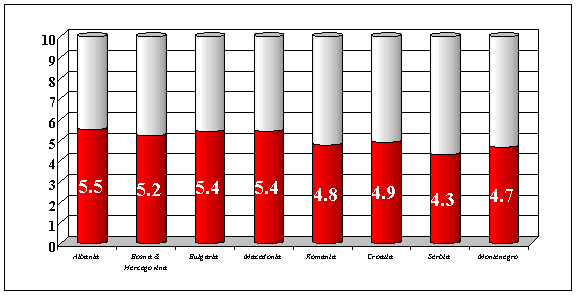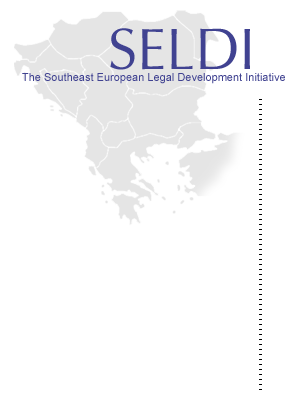

CORRUPTION INDEXES
Regional Corruption Monitoring in
Albania, Bosnia and Herzegovina, Bulgaria, Croatia, Macedonia, Romania, and Yugoslavia
March 2001
The present report outlines the key findings of the Regional Corruption Monitoring carried out in seven countries of South Eastern Europe - Albania, Bosnia and Herzegovina, Bulgaria, Macedonia, Romania, the Federal Republic of Yugoslavia (Serbia and Montenegro), and Croatia. The surveys conducted in these countries were based on the methodology of the Corruption Monitoring System of Coalition 2000 and marked the beginning of the implementation of a Regional Corruption Monitoring System of SELDI. The main goal of this comparative analysis of the seven countries from the Balkan region is to show the public significance of the problem of corruption and the extent to which corruption has penetrated into the various elements of society.
Sample Size
National representative survey of the population aged 18+ in each country.
Sample Size | |
Albania | 1001 |
Bosnia and Herzegovina | 1000 |
Bulgaria | 1158 |
Macedonia | 1000 |
Romania | 1000 |
Croatia | 1000 |
Serbia | 976 |
Montenegro | 604 |
Survey method
The survey method used is face-to-face interview.
Field work
Field work was conducted between September 15, 2000 - February 13, 2001.
- Corruption indexes numbers assume values from 0-10.
- The closer the value of the indexes is to 10, the more negative are the assessments of the respective aspect of corruption. Index numbers closer to 0 indicate approximation to the ideal of a "corruption-free" society.
- Corruption indexes have been grouped into several categories:
- Attitudes towards corruption;
- Corrupt practices;
- Assessment of the spread of corruption;
- Corruption-related expectations.
MAIN PROBLEMS FACED BY THE BALKAN COUNTRIES
The most important problems of the Balkan countries at present are social and economic - unemployment, poverty, low incomes. The issues related to government, the political system, and ethnic tensions increasingly tend to be considered of secondary importance among public priorities. By its scope and depth, the problem of corruption is serious importance to the countries in the region. Its importance is accounted for by the fact that corruption tends to infiltrate economic life, governments, political systems, and institutional structures in these societies.
TABLE 1. MAIN PROBLEMS IN THE COUNTRIES OF SEE
v | Albania | Bosnia and Herzegovina | Bulgaria | Macedonia | Romania | Croatia | Serbia | Montenegro |
Unemployment | 44,40% | 60,90% | 67,80% | 75,30% | 39,50% | 66,00% | 30,30% | 53,10% |
Low incomes | 39,30% | 39,60% | 49,00% | 62,00% | 41,30% | 39,10% | 39,20% | 35,60% |
Poverty | 24,40% | 29,80% | 41,50% | 1,10% | 50,60% | 31,60% | 39,70% | 34,80% |
Corruption | 60,80% | 47,60% | 37,50% | 35,10% | 59,90% | 41,70% | 37,20% | 30,80% |
Crime | 36,00% | 32,90% | 25,70% | 27,60% | 10,20% | 33,50% | 44,10% | 31,50% |
High prices | 24,00% | 10,90% | 22,40% | 25,40% | 35,60% | 27,30% | 24,70% | 21,20% |
Political instability | 49,60% | 37,00% | 17,00% | 33,20% | 29,90% | 20,10% | 47,80% | 59,30% |
Health Care | 3,70% | 9,90% | 14,00% | 7,20% | 17,40% | 7,10% | 8,70% | 4,00% |
Environment pollution | 5,20% | 3,80% | 2,70% | 6,00% | 1,60% | 2,80% | 2,50% | 4,80% |
Education | 3,90% | 4,60% | 2,10% | 3,70% | 7,90% | 4,40% | 6,30% | 4,50% |
Ethnic problems | 3,00% | 15,60% | 1,70% | 14,90% | 2,40% | 7,00% | 10,20% | 8,60% |
* The total of percentages exceeds 100 as respondents could give up to three answers
Acceptability in Principle
This index reflects the extent to which various corrupt practices are tolerated within the value system.
Its value is highest in Albania, Bosnia and Herzegovina, Macedonia, and Croatia, and lowest, in Bulgaria and Romania. This substantial difference indicates that, in terms of their value system, the citizens of the first four countries are more inclined to accept the existence of corrupt practices in their societies than those in the remaining states. The generally low values of the index in the countries of the region (with the exception of Albania and Bosnia and Herzegovina) show that corruption is widely perceived as morally inadmissible. As a whole, the level of tolerance in principle of the various corrupt practices is relatively low.
FIGURE 1. ACCEPTABILITY IN PRINCIPLE
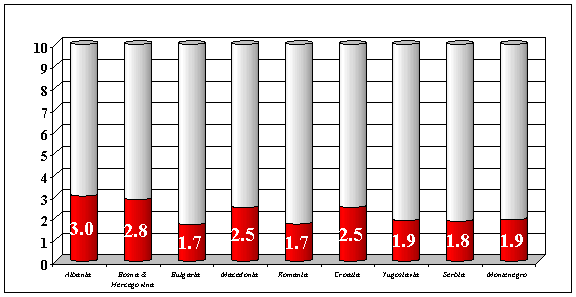
Susceptibility to corruption
This index measures citizens' inclination to compromise on their values under the pressure of practical circumstances.
In all countries the value of this index is higher than the preceding one. This means that the moral denunciation of corruption as a negative phenomenon does not exclude the existence and efficiency of corrupt practices in everyday practice. In cases of conflict between practical interests and value system, many citizens tend to compromise on their principles to achieve their ends. The low tolerance of corrupt behavior and the high susceptibility to such acts are the key preconditions for the following, commonplace philosophy of life: corruption is a "necessary evil" that successfully solves practical problems.
FIGURE 2. SUSCEPTIBILITY TO CORRUPTION
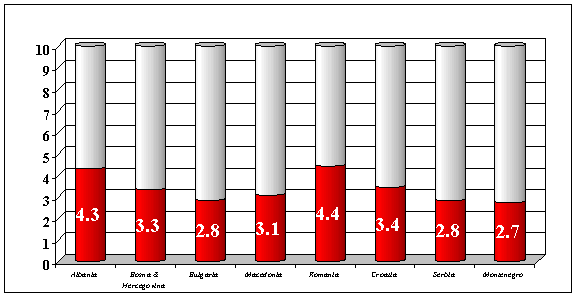
INVOLVEMENT IN CORRUPT PRACTICESINVOLVEMENT IN CORRUPT PRACTICES
Corruption pressure
The index measures the spread of attempts by public sector employees to directly or indirectly pressure citizens in order to solicit money, gifts, or favors.
The values of the index suggest that in the countries of the region involvement in corrupt practices not always a direct outcome of open individual, collective, or institutional coercion. As a whole, corruption pressure in these societies is not particularly intense (with the sole exception of Albania). In the regional context corrupt practices are sustained not so much by social pressure but by the mechanisms of private interests, practical necessity, and personal choice of the citizens and the public sector employees.
FIGURE 3. CORRUPTION PRESSURE
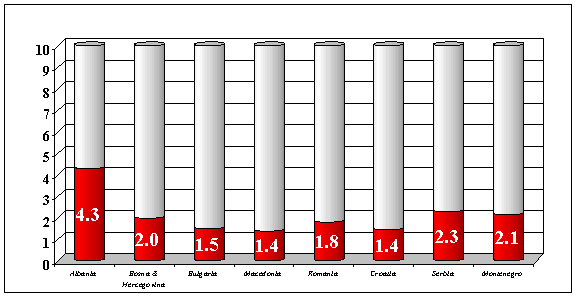
Corruption pressure by professional groups
Table 2 shows the considerable differences when determining the degree of direct coercion on the part of public sector employees over the citizens of the seven Balkan countries. Despite the notable presence of specific national characteristics, there is at least one important similarity. It consists in the empirically registered fact that, doctors and public officials (police and customs officers, tax, municipal, and court officials) exert the strongest corruption pressure.
TABLE 2. "IF IN THE COURSE OF THE PAST YEAR IF YOU HAVE BEEN ASKED FOR SOMETHING IN ORDER TO HAVE A PROBLEM OF YOURS SOLVED, YOU WERE ASKED BY:"
v | Albania | Bosnia and Herzegovina | Bulgaria | Macedonia | Romania | Croatia | Serbia | Montenegro |
Police officer | 52,00% | 25,70% | 24,00% | 14,40% | 34,00% | 24,80% | 42,40% | 38,40% |
Doctor | 62,60% | 19,90% | 22,10% | 20,20% | 35,10% | 16,60% | 33,60% | 19,50% |
Customs officer | 55,60% | 15,90% | 15,80% | 21,80% | 20,50% | 10,50% | 42,80% | 21,60% |
University professor or official | 29,00% | 9,80% | 13,90% | 16,30% | 15,00% | 8,40% | 17,20% | 8,70% |
Administrative official in the judicial system | 47,00% | 9,90% | 11,50% | 10,60% | 22,30% | 6,70% | 19,40% | 9,40% |
Municipal official | 52,50% | 19,10% | 10,30% | 11,90% | 26,90% | 11,30% | 27,20% | 19,30% |
Businessman | 30,50% | 8,50% | 9,70% | 13,20% | 17,80% | 16,10% | 31,60% | 15,80% |
Judge | 53,10% | 8,30% | 9,10% | 13,70% | 16,60% | 5,80% | 19,30% | 7,00% |
Tax official | 56,80% | 8,80% | 8,30% | 8,90% | 10,60% | 6,60% | 22,00% | 13,30% |
Public prosecutor | 39,60% | 3,80% | 7,80% | 8,10% | 10,30% | 2,30% | 12,00% | 4,30% |
Official at a ministry | 39,40% | 13,90% | 7,00% | 13,20% | 10,30% | 8,40% | 15,40% | 7,20% |
Member of parliament | 31,20% | 2,50% | 6,40% | 7,80% | 4,50% | 0,60% | 7,10% | 0,90% |
Investigating officer | 32,70% | 10,10% | 6,00% | 6,60% | 10,60% | 10,90% | 15,30% | 8,20% |
Teacher | 15,40% | 5,70% | 5,50% | 6,70% | 12,70% | 4,50% | 11,70% | 5,90% |
Municipal councilor | 38,90% | 6,90% | 3,20% | 7,80% | 12,40% | 6,50% | 10,20% | 2,50% |
Banker | 19,60% | 3,60% | 2,90% | 5,40% | 7,80% | 5,10% | 13,40% | 3,30% |
* Relative share of those who have had such contacts and have been asked for money, gifts, or services.
Involvement in corrupt practices
This index reflects citizens' reports of their personal involvement in various forms of corrupt behavior.
In terms of actual occurrence, the social reality of corruption in the seven Balkan countries is sustained by a not too large, but stable, segment of the general public and the public sector employees. Notwithstanding a number of specific national features, the younger, the wealthier, the residents of the bigger cities and of the capitals of the Balkan countries, and the better educated are more inclined to adhere to a corruption-based model of behavior than the elderly, those with lower education and living standard, the village and small town residents.
FIGURE 4. INVOLVEMENT IN CORRUPT PRACTICES

ASSESSMENTS OF THE SPREAD OF CORRUPTION
Spread of corruption
This index measures citizens' assessments of the spread of corrupt practices among public sector employees.
Although certain differences between countries exist, overall the values of the index are fairly high for all countries. In the highest degree this applies to Romania, but likewise to Albania, Serbia, Bulgaria, Bosnia and Herzegovina. Though lower, the values registered in Macedonia, Croatia, Montenegro also confirm the above observation. These empirical facts suggest at least two main conclusions. First, according to the public, corruption is widespread in all seven Balkan countries. Second, the findings give reasons to expect that radical changes in these popular assessments are very likely in the foreseeable future.
FIGURE 5. SPREAD OF CORRUPTION
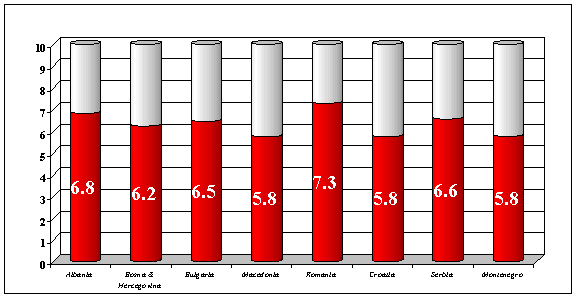
Factors influencing the Spread of corruption
At the level of popular perceptions, the origin of corruption is associated with the social and economic problems of the countries of the region. The most important factor is the manner of functioning of government and its interaction with the public. In Bulgaria, Macedonia and Croatia "the aspiration for fast enrichment of those in power" is cited as the chief factor for the spread of corruption. According to public opinion in the other countries, the main reason for the existence of this social phenomenon is the cheap labor, as well as the ineffectiveness of different elements of social control - legislative, judicial, and administrative.
TABLE 3. FACTORS INFLUENCING THE SPREAD OF CORRUPTION
v | Albania | Bosnia and Herzegovina | Bulgaria | Macedonia | Romania | Croatia | Serbia | Montenegro |
Fast personal enrichment sought by those in power | 49,00% | 41,90% | 57,80% | 69,10% | 55,60% | 49,90% | 46,80% | 53,00% |
Low salaries | 67,50% | 50,50% | 41,60% | 56,20% | 58,00% | 48,70% | 52,60% | 53,60% |
Imperfect legislation | 28,80% | 42,20% | 40,50% | 14,20% | 38,70% | 35,50% | 35,20% | 22,20% |
Intertwinement of official duties and personal interests | 33,30% | 17,50% | 32,60% | 23,50% | 17,90% | 9,70% | 28,70% | 23,70% |
Lack of strict administrative control | 40,60% | 27,90% | 32,30% | 17,10% | 30,90% | 24,10% | 21,50% | 22,70% |
Ineffectiveness of the judicial system | 19,50% | 32,50% | 22,20% | 37,90% | 33,80% | 33,10% | 24,60% | 19,20% |
Moral crisis in the period of transition | 24,50% | 30,50% | 17,00% | 23,00% | 26,50% | 36,20% | 37,20% | 50,00% |
Problems inherited from the communist past | 20,70% | 17,10% | 7,80% | 11,80% | 18,00% | 22,20% | 19,20% | 12,70% |
Specific characteristics of Bulgarian national culture | 7,60% | 19,70% | 4,20% | 9,00% | 5,20% | 5,30% | 15,90% | 16,60% |
Spread of corruption by professional groups
Public opinion in the seven Balkan countries assesses differently the level of corruption among professional groups. Nevertheless, there are certain occupations for which could be considered the "hotbeds" of corruption. These are the customs, tax, and municipal administrations, the court system and the police, the central executive and legislative powers. It should be noted that in all seven countries (perhaps with the exception of Montenegro) corruption is least widespread among the representatives of non-governmental organizations, the journalists, and the teachers.
TABLE 4. "ACCORDING TO YOU, HOW WIDESPREAD IS CORRUPTION AMONG THE FOLLOWING GROUPS:"
v | "Nearly all" and "most” are involved in corruption" | |||||||
v | Albania | Bosnia and Herzegovina | Bulgaria | Macedonia | Romania | Croatia | Serbia | Monte-negro |
Customs officers | 86,6% | 58,8% | 75,2% | 72,2% | 63,4% | 51,3% | 80,9% | 27,3% |
Ministers | 67,8% | 54,2% | 55,0% | 61,0% | 58,0% | 37,3% | 55,3% | 16,2% |
Police officers | 56,4% | 46,5% | 54,3% | 46,3% | 64,4% | 47,3% | 73,2% | 18,7% |
Tax officials | 79,0% | 54,4% | 53,7% | 52,3% | 49,0% | 40,6% | 63,5% | 16,2% |
Lawyers | 70,6% | 41,0% | 52,9% | 42,2% | 55,2% | 45,3% | 55,7% | 13,4% |
Members of parliament | 61,8% | 47,5% | 51,7% | 60,8% | 65,9% | 33,1% | 45,9% | 6,6% |
Public prosecutors | 70,9% | 37,8% | 51,3% | 39,4% | 49,3% | 29,6% | 56,8% | 32,5% |
Judges | 80,1% | 42,6% | 50,1% | 49,2% | 55,7% | 38,4% | 63,7% | 37,7% |
Officials at ministries | 66,2% | 52,5% | 49,7% | 47,5% | 54,5% | 47,0% | 56,1% | 42,5% |
Investigating officers | 52,7% | 44,5% | 43,8% | 29,8% | 45,3% | 28,0% | 57,0% | 33,0% |
Political party and coalition leaders | 54,7% | 56,0% | 43,8% | 44,6% | 53,7% | 39,4% | 58,1% | 13,6% |
Doctors | 71,6% | 48,9% | 43,6% | 45,4% | 54,4% | 53,2% | 62,9% | 11,6% |
Business people | 42,6% | 41,1% | 42,3% | 34,1% | 45,4% | 41,3% | 63,9% | 21,7% |
Municipal officials | 69,1% | 51,4% | 41,6% | 36,8% | 47,9% | 48,1% | 60,1% | 47,0% |
Administration officials in the judicial system | 63,0% | 41,6% | 40,2% | 31,0% | 51,6% | 32,8% | 50,3% | 33,3% |
Local political leaders | 49,6% | 54,7% | 36,8% | 39,1% | 48,0% | 41,9% | 56,9% | 15,2% |
Bankers | 24,4% | 31,9% | 33,5% | 19,7% | 44,8% | 34,0% | 49,2% | 11,4% |
Municipal councilors | 55,2% | 46,2% | 32,1% | 33,4% | 43,1% | 27,7% | 45,0% | 8,4% |
University professors and officials | 46,0% | 35,7% | 28,1% | 42,9% | 24,7% | 40,4% | 39,1% | 25,7% |
Representatives of NGO's | 23,1% | 26,3% | 23,9% | 16,5% | 17,8% | 14,2% | 25,8% | 12,1% |
Journalists | 18,8% | 24,3% | 13,9% | 17,1% | 22,1% | 22,8% | 34,0% | 36,3% |
Teachers | 11,6% | 20,9% | 10,9% | 18,7% | 20,4% | 19,3% | 28,5% | 18,0% |
Spread of corruption among institutions
The institutional spread of corruption in the seven Balkan countries largely reproduces the level of corrupt practices registered for the different professional groups. Customs, tax administrations and the judicial system stand out among the state institutions cited as centers of "big" corruption by the citizens of Albania, Bosnia and Herzegovina, Bulgaria, Macedonia, Romania, Croatia, and Yugoslavia (Serbia and Montenegro). In all seven countries, the rate of corruption is lowest in the national armies, the presidential institutions (with the exception of Romania, Bosnia and Herzegovina, Serbia, and Montenegro). The national statistical institutes and the national banks (once again, with the slight exception of Serbia and Montenegro and, to some extent, of Croatia) are the social "locations" with least corruption.
TABLE 5. "ACCORDING TO YOU, HOW WIDESPREAD IS CORRUPTION IN THE FOLLOWING INSTITUTIONS:"
| Albania | Bosnia and Herzegovina | Bulgaria | Macedonia | Romania | Croatia | Serbia** | Monte-negro |
Customs | 8.84 | 7.88 | 8.90 | 8.80 | 8.60 | 6.90 | 8.68 | 8.20 |
Privatization Agency | 7.56 | 7.36 | 8.06 | 8.08 | 8.68 | 7.70 | 7.46 | 7.44 |
Judiciary | 8.48 | 6.74 | 7.60 | 7.38 | 8.02 | 6.66 | 7.78 | 6.58 |
Tax offices | 8.36 | 7.66 | 7.54 | 7.72 | 7.48 | 6.74 | 7.88 | 7.38 |
Agency for Foreign Investment | 6.04 | 6.46 | 7.54 | 7.86 | 6.64 | 6.84 | - | - |
Industry line ministries | 7.60 | 7.14 | 7.50 | 7.82 | 7.98 | 6.94 | 7.76 | 6.96 |
Government | 8.10 | 7.78 | 7.44 | 8.06 | 7.96 | 6.28 | 7.32 | 6.86 |
Parliament | 7.38 | 7.32 | 7.42 | 7.84 | 8.18 | 5.92 | 7.04 | 6.08 |
Police | 7.24 | 6.96 | 7.14 | 7.12 | 7.78 | 6.98 | 8.08 | 7.24 |
Committee on Energy | 7.18 | 6.30 | 7.00 | - | 6.64 | 6.86 | 6.80 | 5.62 |
Municipal government | 7.54 | 7.56 | 6.94 | 6.94 | 7.40 | 7.10 | 7.38 | 7.18 |
National Telecommunications Company | 6.90 | 6.28 | 6.60 | 6.28 | 6.74 | 6.72 | 6.26 | 5.50 |
Municipal administration | 7.50 | 7.32 | 6.54 | 6.50 | 7.38 | 6.80 | 7.24 | 7.12 |
Commission for the Protection of Competition | - | 6.84 | 6.54 | - | 6.38 | 6.42 | - | - |
Securities and Stock Exchanges Commission | 6.62 | 6.70 | 6.46 | - | 7.28 | 6.46 | - | - |
Audit Office | 7.18 | 7.06 | 5.98 | - | 5.96 | 6.26 | 6.26 | 5.82 |
National Bank | 5.56 | 6.44 | 5.72 | 5.92 | 5.70 | 6.02 | 6.58 | 6.08 |
National Institute of Statistics | 4.30 | 7.36 | 5.02 | 4.38 | 4.48 | 4.58 | 5.46 | 4.78 |
Army | 5.92 | 6.78 | 4.98 | 4.40 | 4.90 | 5.98 | 5.42 | 5.88 |
Presidency | 6.10 | 7.18 | 4.52 | 4.72 | 6.36 | 4.66 | 7.68 | 5.68 |
* In this table the list of institutions in based on their names in Bulgaria. The data for each country refers to the respective institutions in these countries.
* The respondents from Serbia and Montenegro assessed the President institution of Yugoslavia.
Practical efficiency of corruption
This index measures citizens' assessment of the extent to which corruption is becoming an effective means of solving private problems.
The values of the index suggest that the practical effectiveness of corrupt practices is highest in Romania, Albania, and Serbia, and lowest, in Macedonia. The extremely high index values indicate that a large part of the citizens consider corrupt behavior to be a practically successful social practice. These two facts mean that in the Balkan context corruption has come to be firmly perceived as an efficient instrument for dealing with problematic situations. Hence the more general conclusion that unless the social environment favoring corruption undergoes substantial transformation, there is no reason to expect any radical changes.
FIGURE 6. PRACTICAL EFFICIENCY OF CORRUPTION
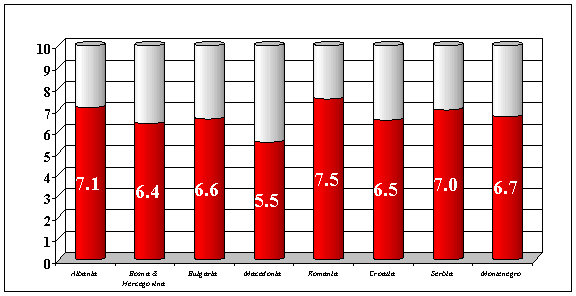
This index reflects citizens' assessments of the capacity (potential) of their societies to cope with the problem of corruption.
The high values of this index in all of the countries suggest that pessimism generally tends to prevail regarding the possibility of coping with corruption. According to public opinion in Albania, Bosnia and Herzegovina, Bulgaria, Macedonia, Romania, Croatia, and FR Yugoslavia, the negative implications of this phenomenon can hardly be eliminated unless the very preconditions for its existence are removed. The citizens of the Balkan countries are not extreme fatalists regarding the potential of their societies to overcome corruption, but rather, moderate pessimists. Nevertheless, they are likely to change their basic expectations, if legitimate mechanisms in the social environment that actually prove more effective than corruption emerge.
FIGURE 7. CORRUPTION EXPECTATIONS
